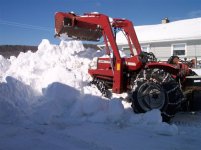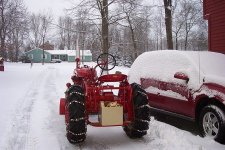JoeL4330
Platinum Member
Hmmmm...I tried to find an authoritative source for "why" ...none of the web sites that provide installation instructions suggest airing up-down, and this one http://www.partsamerica.com/MaintenanceTireChainsRules.aspx?PA_Portal_Id=advance-auto says it's a no-no, but not why
This site AUTOS & BOATS : Tires : Selecting and Installing Tire Chains : DIY Network does say that "...If you can slip your hand between the tire and the chain, under a cross chain or a side chain, then the chains are too loose."
This site is a tiny bit more explanatory 4chains "...Some of the old timers used to recommend deflating tires to install tire chains and then pumping them up again. I don't recommend this, it puts a tremendous load on the chains. Your tires should be normal pressure."
Here's what TireRack Winter Tech - Tire Chains for Winter Use at The Tire Rack. has to say: "Buy chains that are the correct size for the tires. A proper fit is key to receiving the desired performance and durability. Do not deflate tires to install tire chains. A correctly sized tire chain will fit over a properly inflated tire. Additionally, because there is typically no source of compressed air to refill a deflated tire, driving with low tire pressure may cause permanent damage to the tire. Snow chains may not be available for all tire sizes."
As I say, no one recommends airing up-down. Now, I must confess that I (an old timer) have done it--small amount of deflation, tighten, then back up to recommended pressure--and it puts quite a strain on the chains. It is the side chains that "feel the pressure" and they are the "weak link" ...often smaller and not hardened. More importantly, the fastener is probably weakest point of all and I suspect I could be aggressive enough to send it flyin'--like a piece of shrapnel ...but, I guess I won't try it. Note that that small amount of tire pressure in your tire is enough to lift the vehicle, of course.
This site AUTOS & BOATS : Tires : Selecting and Installing Tire Chains : DIY Network does say that "...If you can slip your hand between the tire and the chain, under a cross chain or a side chain, then the chains are too loose."
This site is a tiny bit more explanatory 4chains "...Some of the old timers used to recommend deflating tires to install tire chains and then pumping them up again. I don't recommend this, it puts a tremendous load on the chains. Your tires should be normal pressure."
Here's what TireRack Winter Tech - Tire Chains for Winter Use at The Tire Rack. has to say: "Buy chains that are the correct size for the tires. A proper fit is key to receiving the desired performance and durability. Do not deflate tires to install tire chains. A correctly sized tire chain will fit over a properly inflated tire. Additionally, because there is typically no source of compressed air to refill a deflated tire, driving with low tire pressure may cause permanent damage to the tire. Snow chains may not be available for all tire sizes."
As I say, no one recommends airing up-down. Now, I must confess that I (an old timer) have done it--small amount of deflation, tighten, then back up to recommended pressure--and it puts quite a strain on the chains. It is the side chains that "feel the pressure" and they are the "weak link" ...often smaller and not hardened. More importantly, the fastener is probably weakest point of all and I suspect I could be aggressive enough to send it flyin'--like a piece of shrapnel ...but, I guess I won't try it. Note that that small amount of tire pressure in your tire is enough to lift the vehicle, of course.


